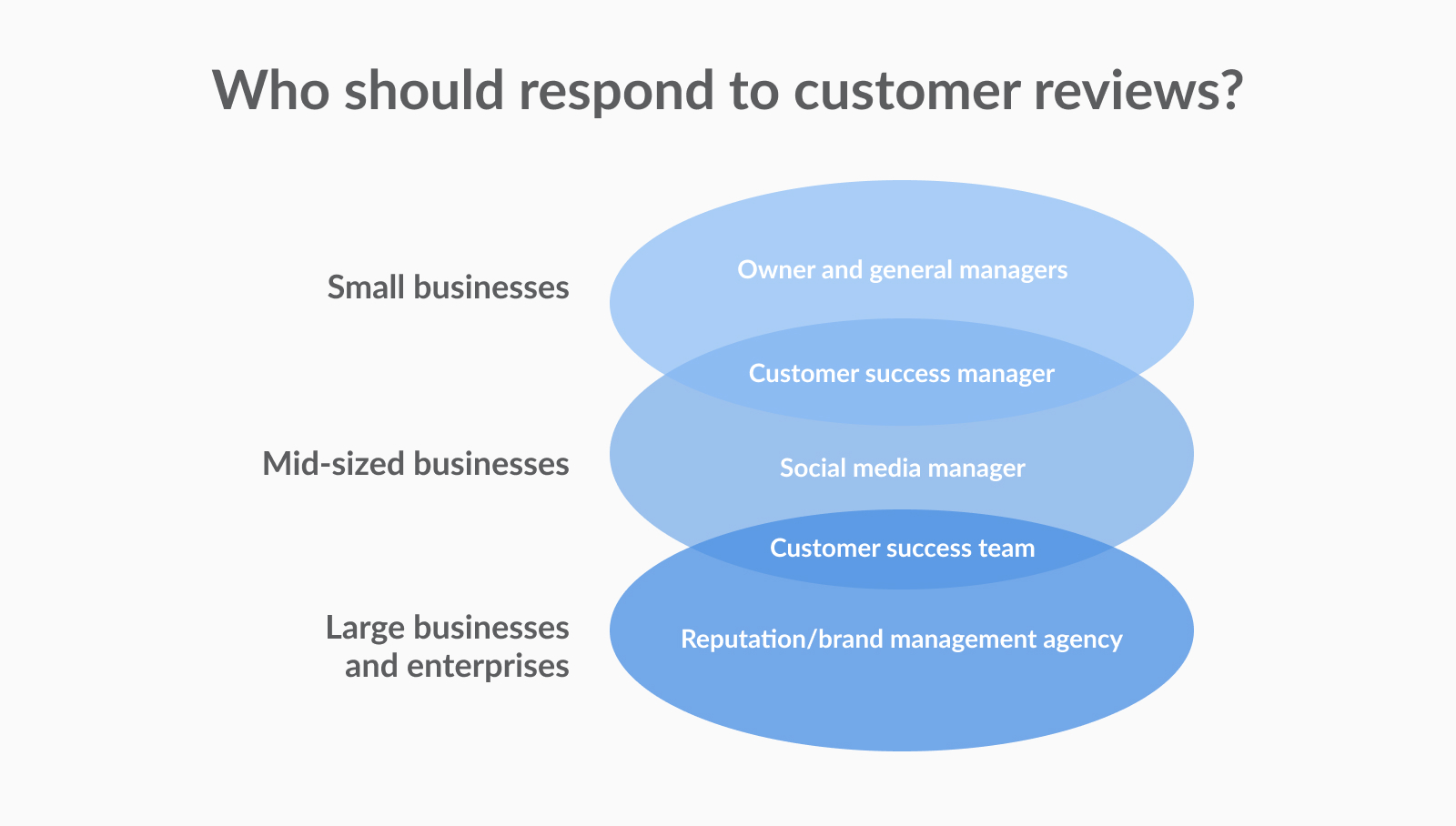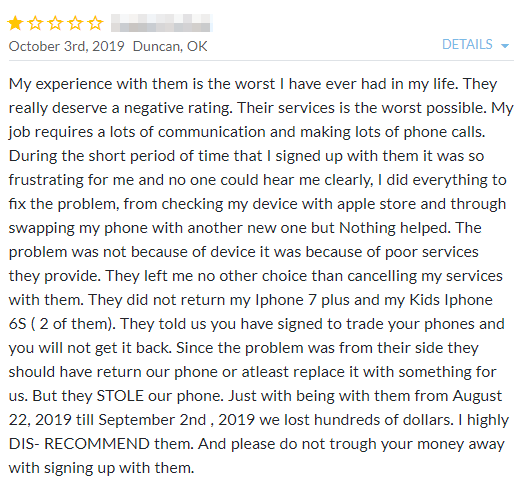
Everyone has to deal with negative feedback. It’s how we grow.
Your business is the same, but that feedback hurts when it’s damaging your reputation. That’s why it’s important for you to know how to respond to negative reviews.
You may have read our overview of how to respond to reviews, but now we’re going in depth on how to manage negative reviews, turn them into learning opportunities, and maybe even change some unhappy customers’ minds.
If you missed the overview, here’s a quick recap of why responding to your negative reviews is important:
- 45% of customers are more likely to visit your business if your company responds to negative reviews.
- 18% of the negative reviewers who receive a response become a loyal customer.
- 65% of reviewers will stop using a company if their review isn’t addressed.
Ready to earn some loyal customers? Let’s walk through what you need to know about negative reviews.
Best practices for responding to negative reviews
Before we get into specifics, let’s cover the general best practices for responding to a bad review.
Always respond
Respond to all your negative reviews. Sure, you can have some wiggle room with your positive reviews — nobody’s perfect, and having that kind of bandwidth is difficult. But if a customer walked into your store with a complaint, wouldn’t you spare some time to help them? Of course!
Since the stats show that many customers want you to respond to negative reviews, do your best to respond to all recent negative reviews.
Respond quickly
Most customers want a response to their review in 24 hours. That makes sense — reviewers are less likely to double back and check a review platform after a couple days of crickets.
You need to be quick on the draw. If your team is spread thin, hire someone dedicated to reputation management, or if that’s not in the budget, consider outsourcing to a team capable of responding to your reviews. But that’s as a last resort, as you’ll see with our next point.
Keep it personalized
Customers are all about personalization. That’s why you should follow this hierarchy of who will respond to a review. Keep in mind that the larger your business is, the higher volume of reviews you’ll receive, and the more likely you’ll have to defer to another person in the hierarchy to manage review responses.

But also remember this: The further you have to outsource reputation management from your company's problem-solvers, the more difficult it will be to give negative reviewers a resolution. A manager can offer refunds and redeliveries as they please; a customer success team will have to escalate a review for a solution.
You’ve probably seen the form responses companies use for bad reviews: “We apologize for your experience, [NAME]. Please reach out to us at [NUMBER] so we can help you resolve this issue.” Having the right number of personnel addressing your reviews will help you avoid this sterile approach.
But don’t throw the template away. If you're overwhelmed by reviews, with even limited personalization, it can be an efficient response: “We’re sorry to hear about your bad experience, [NAME]. [Empathize with their statement here.] We’d love to get you in touch with [CUSTOMER SUCCESS ASSOCIATE] to resolve this issue. You can reach them at [NUMBER].”
Practice sympathy
You might not get it. At all. Your reviewer may be complaining about something completely out of your control, such as delayed shipping or arriving after your store's closing time. As ridiculous as their complaints may be, try to understand where they’re coming from. Responding with grace shows others that your customer service team can be the bigger person.
Move the issue offline
As entertaining as forum fights are, leave your nasty comments out of the replies. Responding to reviews is both PR and customer service, and all your future customers can see your replies. That’s why it’s best to move the issue to a channel where a negative reviewer can’t damage your reputation further.
After you give your heartfelt public reply, reach out to the customer through private message to continue the conversation. A phone call is preferable to talk about the customer complaints, but email can suffice. If you can’t get ahold of the customer because the review platform doesn’t offer that feature or the customer isn’t responding, leave your contact information so they can speak with you. Be aware that this won’t always be seen if you're DMing on a review platform, because some customers never revisit a review platform after their review.
Log the feedback
Are you getting complaints for the same issues? Time to do some data analysis. Always collect reviews and organize them into buckets by the type of feedback. This can help your team see where there’s room for improvement.

How to respond to different types of negative reviews [+templates and examples]
Negative reviews with no comments
Some review platforms don’t require customers to comment, like Google and Facebook; it’s an easy way to get more users to take the plunge and leave a review. But a bad review with no comments means that you don’t get any insight into where you went wrong.

This is what you can do to get some answers from a negative reviewer who doesn’t leave a comment:
- Apologize for their experience. You don’t know the specifics, but leading with sympathy can open doors.
- Ask for more information. It’s unlikely they’ll take you up on your offer, but nothing ventured, nothing gained. See if you can get their feedback.
- Leave your contact information with them. If you can’t get ahold of them, perhaps they’ll get ahold of you.
Read also: The Pros and Cons of Google Reviews
Brief reviews
Some reviewers will leave one-word or one-sentence reviews. This is common for review sites that don’t require a character account (again, such as Google and Facebook), but even those with character limits find angry customers trying to stretch the rules on content quality.

Since we’re focusing on responding to negative reviews, it’s probably for the best that this reviewer didn’t wax poetic. But on the other hand, you don’t know much about where you can improve.
Your response to a spammy review can be similar to a review with no comment, with only a couple key differences:
- Express sympathy for their specific concern. If all they said was, “Terrible customer service,” be sure to mention that you apologize for their experience with your service in your response.
- Hint that this was a one-off situation. Unless you’ve gotten piles of reviews with similar complaints for your terrible customer service, say something along the lines of, “We hold our customer service team to a high standard and we're sorry that they did not meet your expectations.”
Fake reviews
It can be hard to tell if you have a fake review on your hands.
Some review platforms will want you to respond first; others won’t. But if you can’t get what you believe to be a fake negative review removed, it’s in your best interest to respond. Here are some tips for making the most of this less-than-ideal situation:
- Take time to collect yourself. Fake reviews are inflammatory — don’t respond to their bad vibes with more bad vibes. Customers are reading! And if the fake reviewer wants to tarnish your reputation, they’ll win twice over if you fight fire with fire.
- If the review contains something factually incorrect, it’s fine to gently point out the mistake. If the review mentions coming in on a date you aren’t open, let them know that there must be some mistake. If they complain about someone who isn’t on your staff, tell them that no one with that name works with your company.
- Don’t go all-in on calling them out. It’s fine to point out a fake reviewer’s “mistakes,” but declaring their review fake might discourage readers who already mistrust brands. Instead, treat it otherwise like a genuine negative review.
- Ask the reviewer to get in touch. If they’re a fraudulent reviewer, they won’t take you up on the offer. But this will show the people who actually matter in this damage control — your future customers — that you prioritize customer service.
Balanced negative reviews
This type of review can be one or two stars, but while the gist of the review is overwhelmingly negative, the reviewer also mentions some positive aspects of the product.

It can be tempting to latch onto the good in the hopes that it overshadows criticism, but you’ll still need to face their concerns as you respond:
- Match with a balanced response. Briefly thank the reviewer for the compliment(s), then follow standard negative review response protocol for the remainder, expressing apologies and reaching out offline.
Detailed negative reviews

Negative reviews tend to have higher word counts than positive reviews. Most negative reviewers believe that their whole story is integral to understanding their complaint. But as a result, their reviews end up taking a lot of real estate on your page, even when truncated with a “Read More.” Here’s how you can respond to your own Wordy Will:
- Resist the urge to match their format. Review readers typically see long negative reviews as unhinged unless they’ve had a similar experience. If you write your own novel in response to inflammatory remarks, bystanders are going to consider both parties unreasonable.
- Don’t ask for their feedback online. If there’s a reply feature, you’re likely to get another earful. Reach out through another channel, like email or phone.
Request a rescore
You want that star average to rise, don’t you? Rescore requests are one method that companies often overlook — it seems easier to bury negative reviews with a landslide of positive reviews.
But don’t forget that going out of your way to help angry customers has its own reward. Remember, 18 percent of the negative reviewers that receive a response become loyal customers. Seems small, but that’s one-fifth of angry customers willing to give you a second chance.
Here are the steps to earning more business and earning a higher rating through a rescore request:
- Respond publicly, but don’t ask for a rescore yet. This is to save face with the customers reading your negative review, so they know that no matter how this pans out on the other side of the screen, you’re not ignoring a complaint.
- Reach out privately. Calling is best, but you may not know the customer's number. Your second option is text or email. If those don’t apply, DM the customer through the review platform.
- Get your customer success team on the case. This is a job for the experts in conflict resolution.
- Offer your solutions. Bad haircut? Perhaps they can come in for a free cleanup. Bad customer service? Offer them a discount the next time they come in.
- Once their tune has changed, mention the review. If you’re getting a “Thank you” from a customer after your hard work, it’s a good time to ask for an update.
The best is yet to come
And for our last tip: Don’t sweat it. Take the feedback seriously, of course, but don’t let it ruin your day. No matter how popular you are, you’ll always have a critic.
Check out your customer reviews and start responding to day to transform bad reviews into new opportunities.
Check out our other tips for responding to reviews and gathering more positive reviews: 8 Tips to Nurture Positive Online Reviews
Want to gather honest reviews from your customers?
Learn how Snoball can help you manage your online reputation and follow up with your verified customers. Schedule a demo today and claim your free profile.
Schedule a Demo